How Accurate Is Google Translate for Your Business? 2024 Research
Is Google Translate accurate? To answer this question, one needs to assess the tool’s translation accuracy across several language pairs. And that’s exactly what we did in our study below.
How does Google Translate work?
Google Translate uses deep neural networks that learn from large volumes of bilingual texts to produce accurate translations. The model is continuously refined through additional training data and user feedback.
Now let’s look under the hood of Google Translate to better understand how it works.
Google Translate’s architecture consists of an encoder-decoder framework and an attention mechanism. The encoder creates a vector representation of the translated text’s meaning. Then, the decoder follows the attention mechanism’s instructions to focus on specific sections of the vector to create a translation.
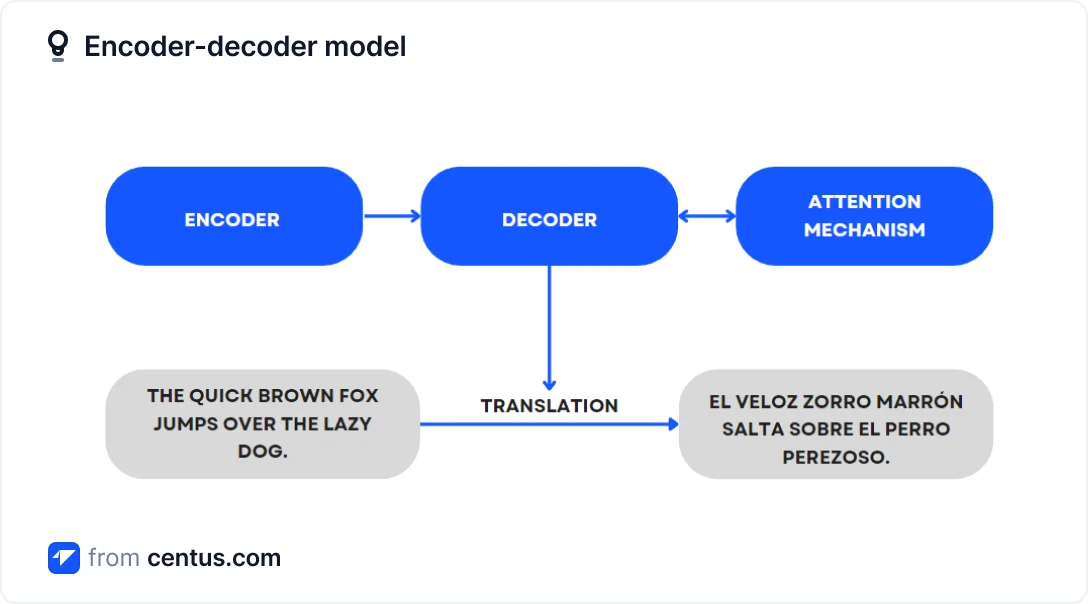
How accurate is Google Translate?
Is Google Translate 100% right? A study reveals that Google Translate’s accuracy rate varies greatly across the supported language pairs from 55 to 94 percent, and the overall accuracy is 82.5 percent.
For instance, Google Translate is 90 percent accurate for the commonly used English-Spanish language pair and only 55 percent for the less frequently used English-Aremenian pair.
In the same vein, Google Translate’s accuracy depends on the type of translated content. Whereas it can reach 90 percent for general Spanish content, it’s only 86 percent for Spanish idioms.
The table below shows how accurate is Google Translate according to a study by Taira et al.
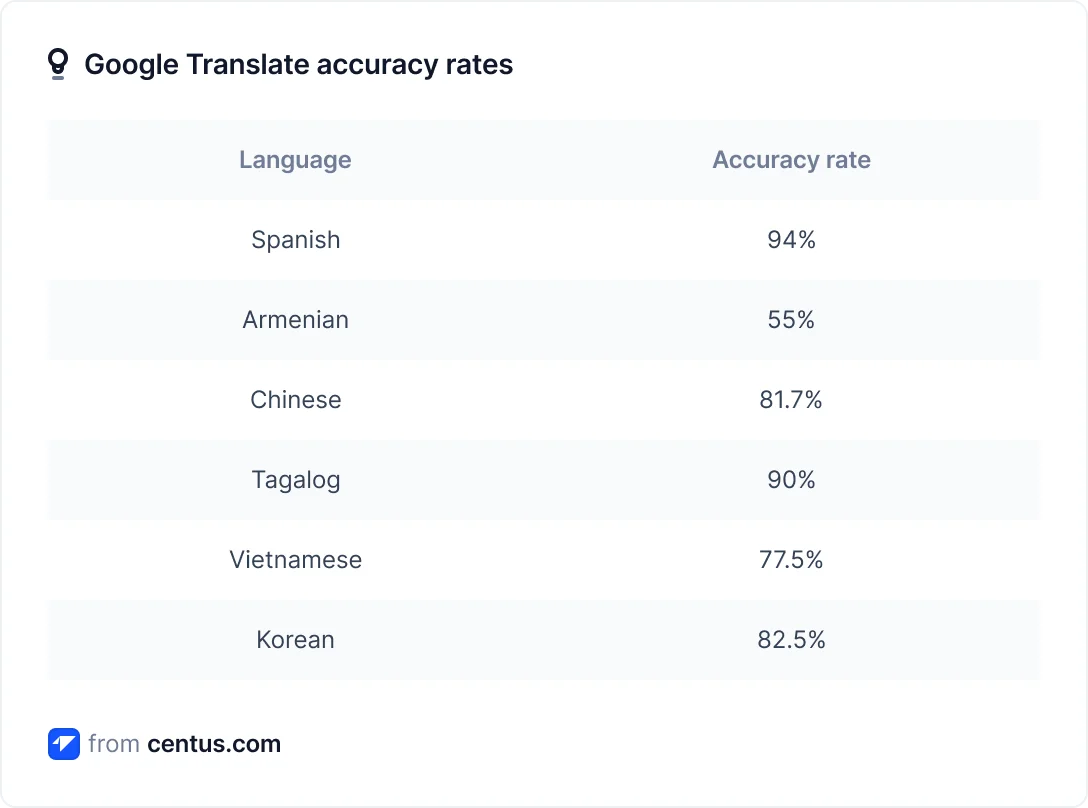
Note, however, that machine translation accuracy is a relative concept and hinges on its application. A customer support specialist might find machine translation software completely accurate, while legal translation experts might deem it unusable.
How to maximize Google Translate’s accuracy
As will be demonstrated in the following sections, Google Translate is not a match for its human counterparts. Nevertheless, you can still use it for business purposes if machine-translated content is reviewed by human editors.
To maximize Google Translate’s accuracy, use Centus localization management platform, where human editors can refine machine translations. Here’s how to use it to translate software, apps, websites, or documents:
- Sign up to Centus
- In the Project dashboard, click New project
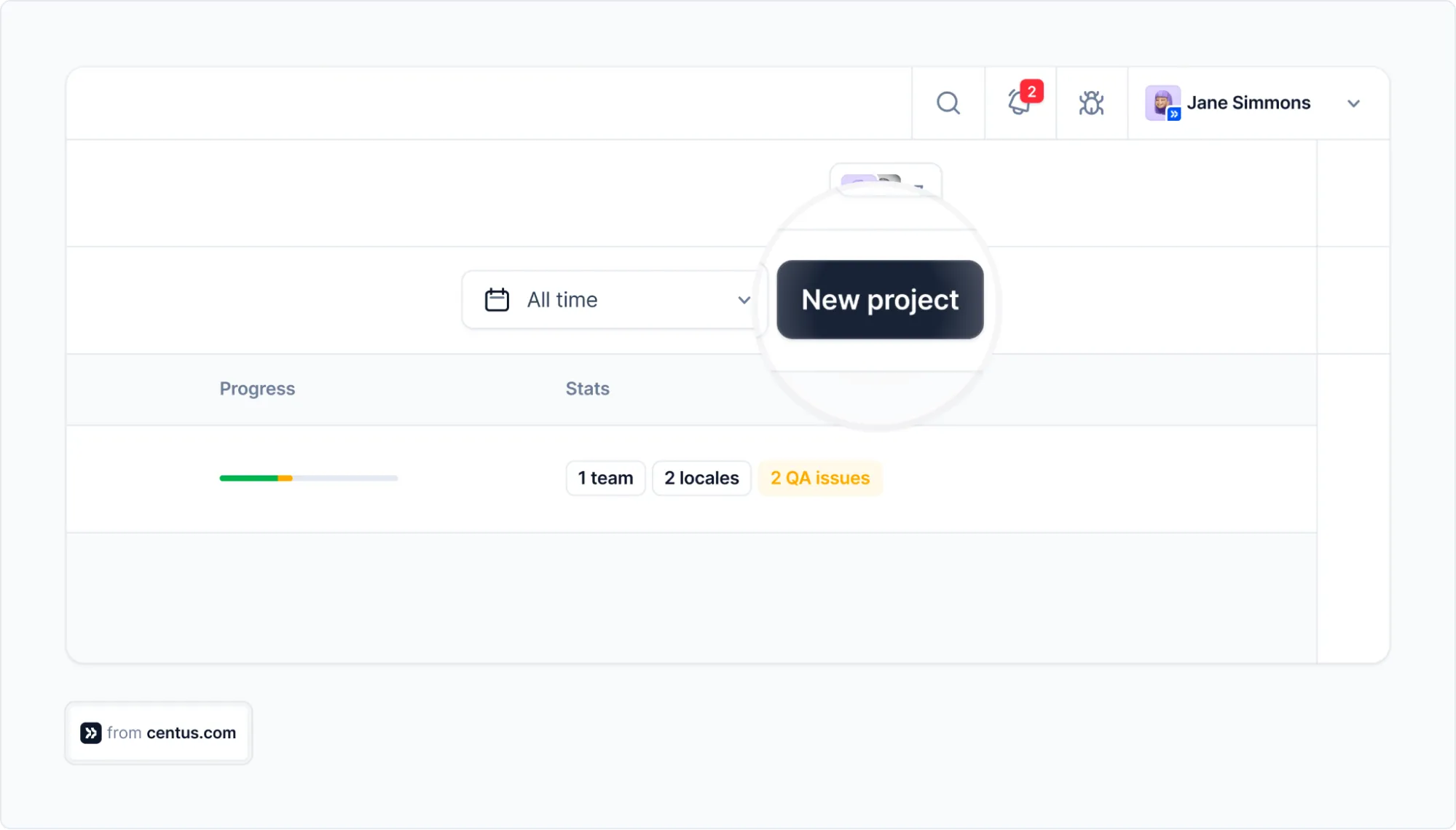
- Enter the project name and choose the source and target languages
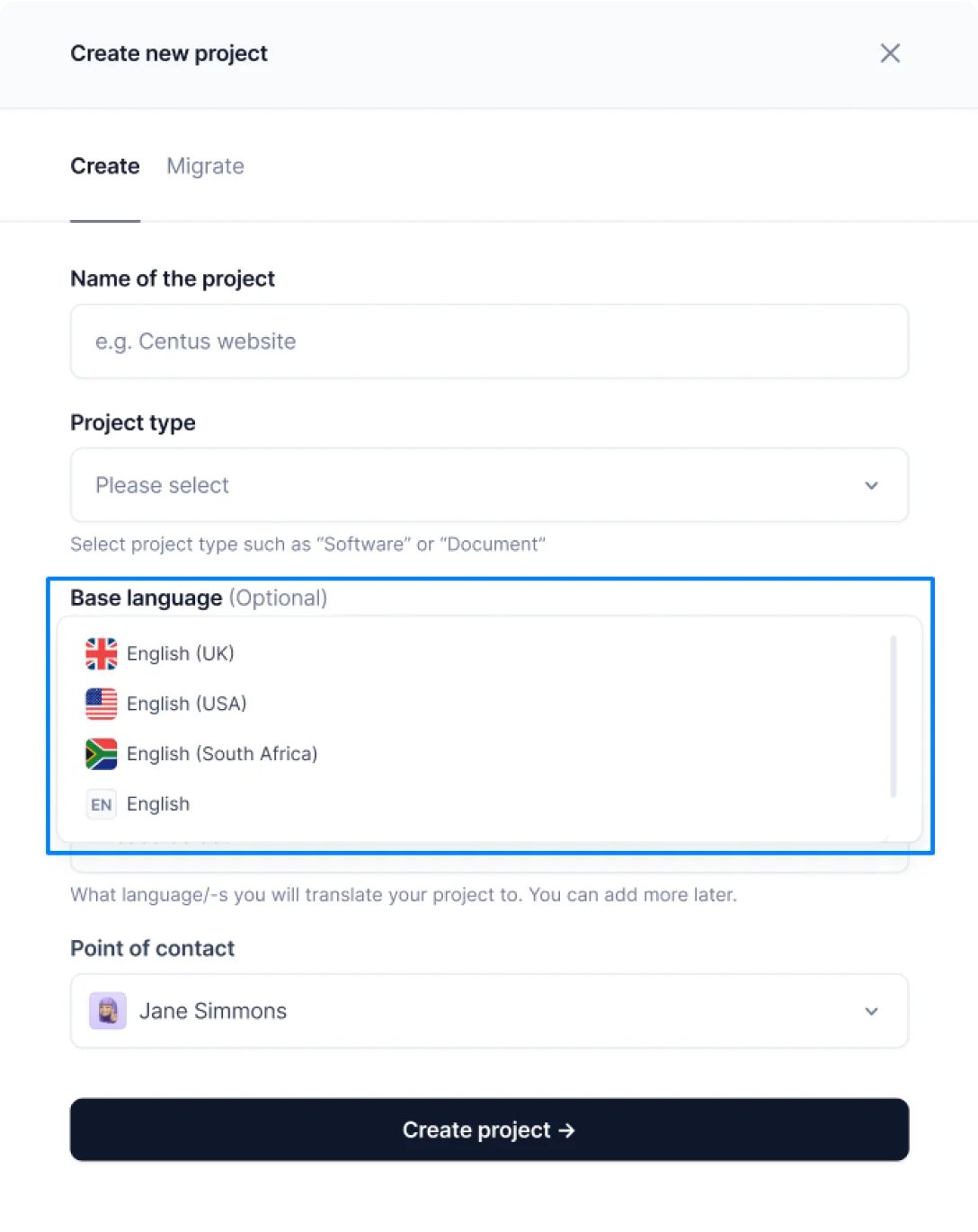
- Click Create project
- In the Imports section, add your HTML, DOCX, or other files for translation
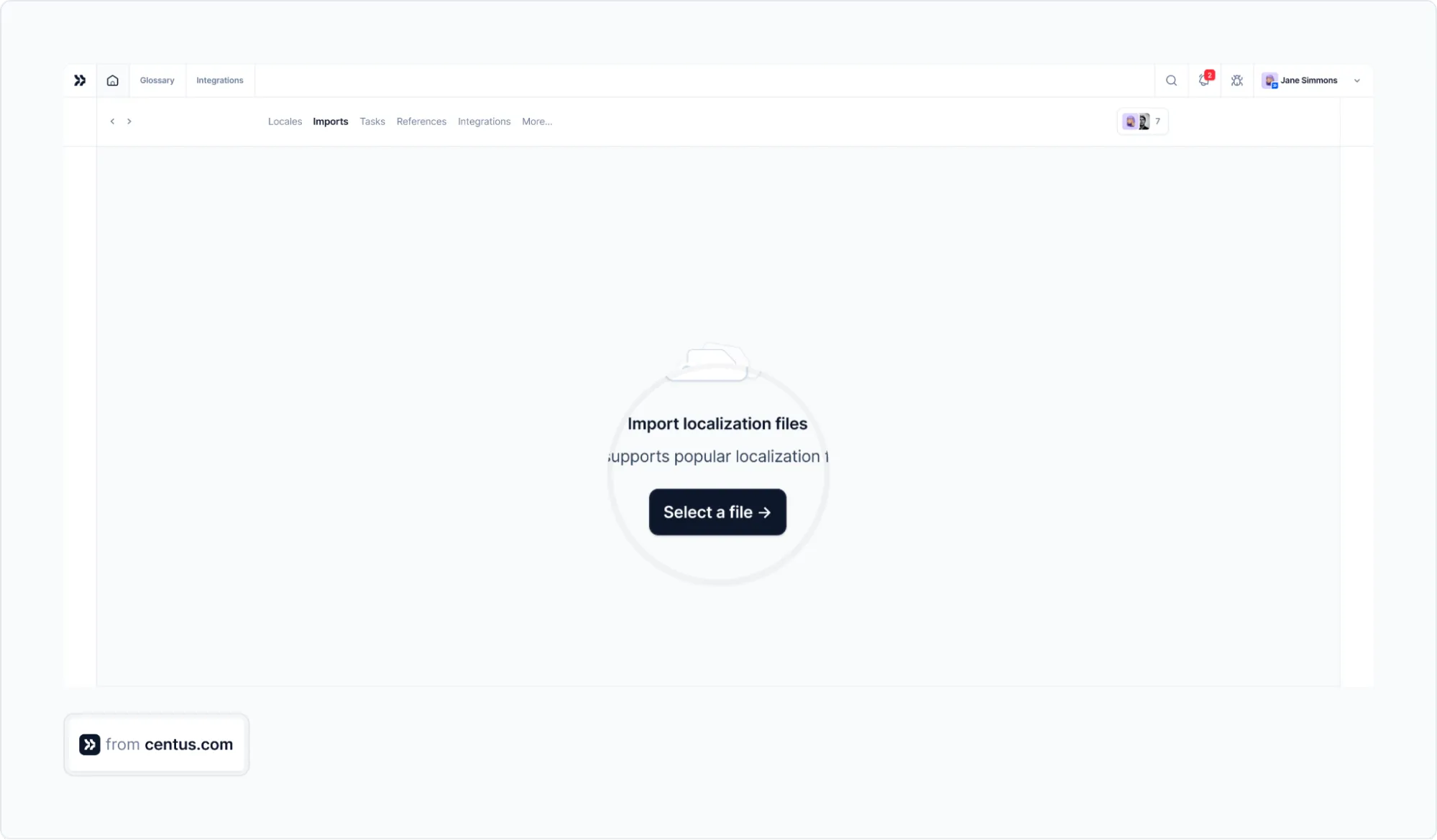
- In the Editor section, you will see your content keys and values
- Click empty values to generate Google Translate translations
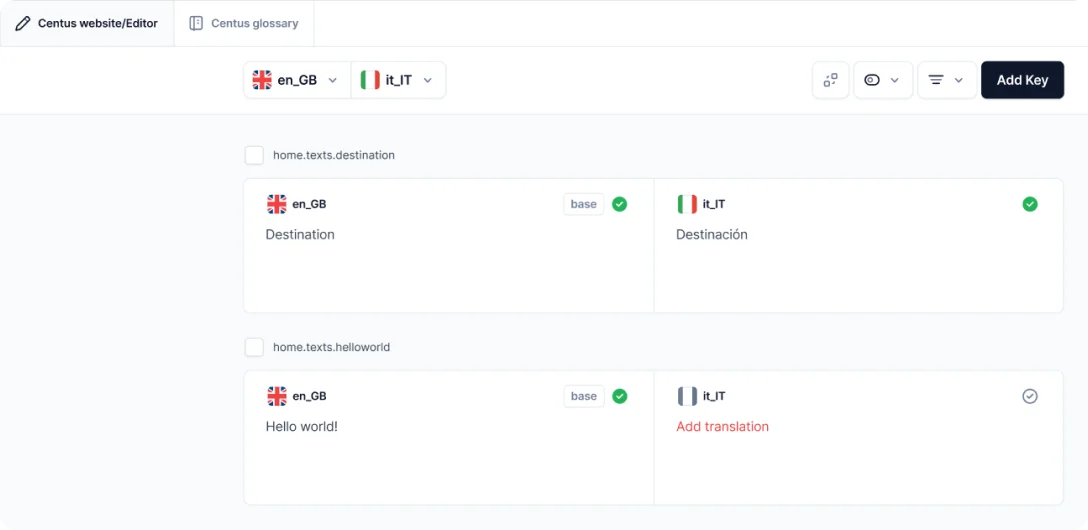
- In the Contributors section, assign human editors to your project

- Let the editors refine your translations and leave comments for your team
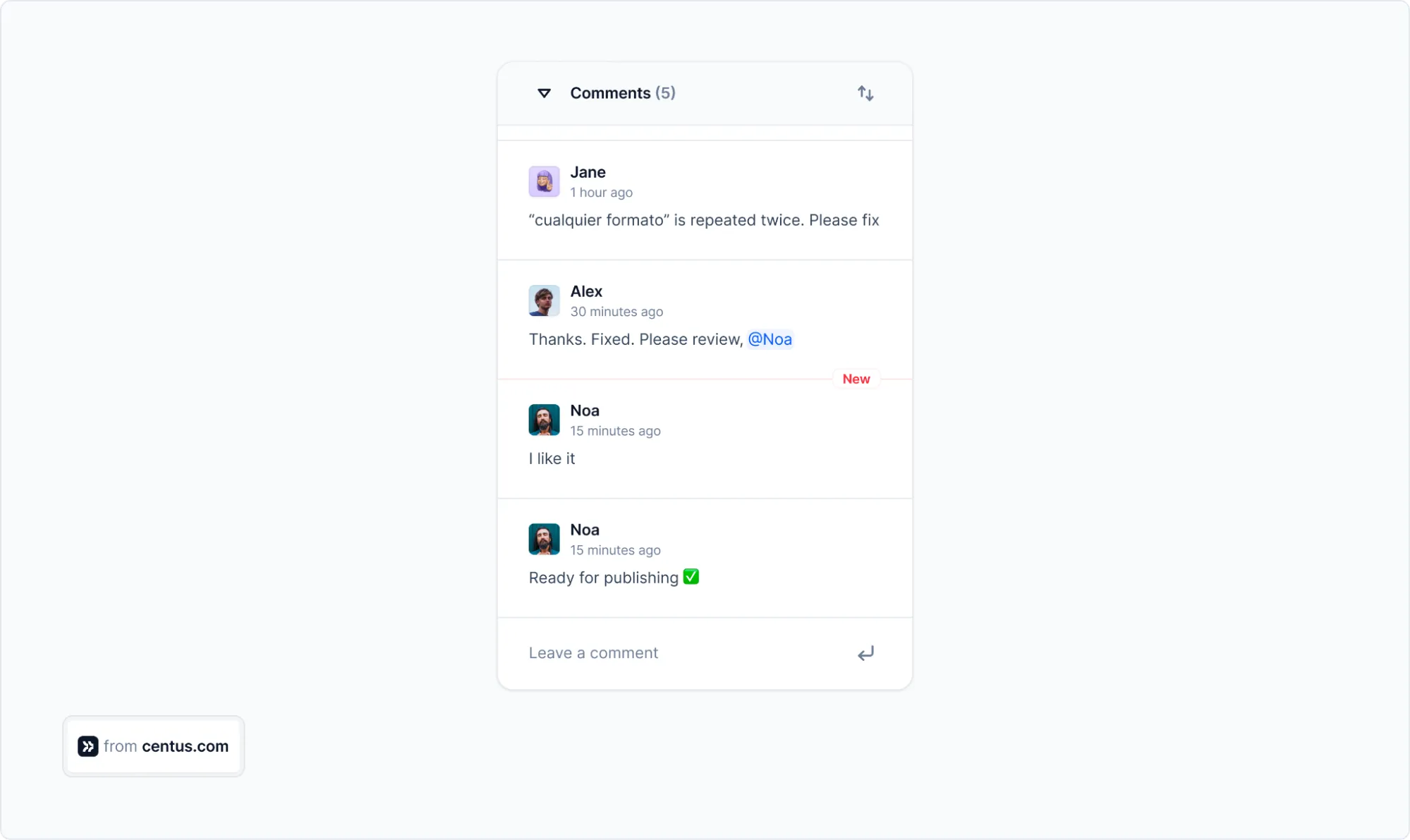
- In the Download section, choose the preferred file format and click Download
With Centus, you can instantly review automatic translation suggestions not only from Google Translate, but also from DeepL and Microsoft Translate. Assign them to human editors to maximize machine translation accuracy and ensure flawless content.
Now, let’s conduct an experiment to evaluate how good Google Translate is.
Google Translate accuracy: English to Spanish
In this experiment, we paired English and Spanish as some of the most frequently used languages in Google Translate.
Although the translation is readable and generally makes sense, it is not suitable for business purposes. See for yourself.
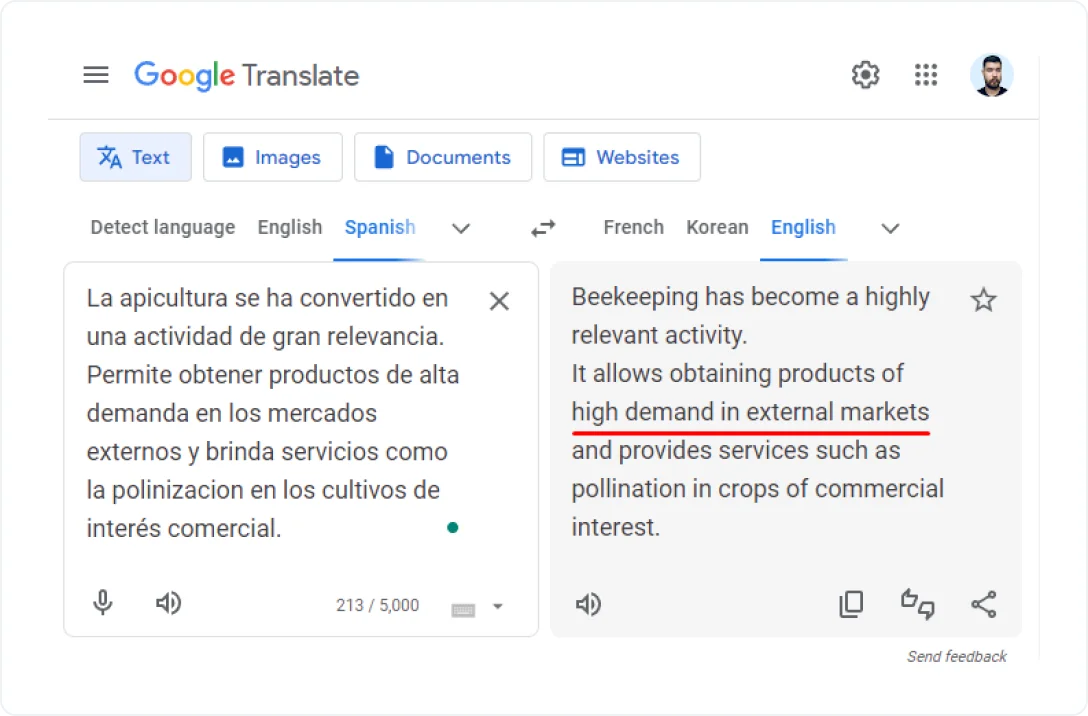
A sentence fragment underlined in red contains a poor choice of words.
So, is Google Translate correct? Yes, Google Translate is reliable, but certainly not suitable for commercial purposes. Not only will Google-translated text be rejected by any legal entity, but it can also damage your brand’s reputation.
Compare translation software to human translation in our experiment.
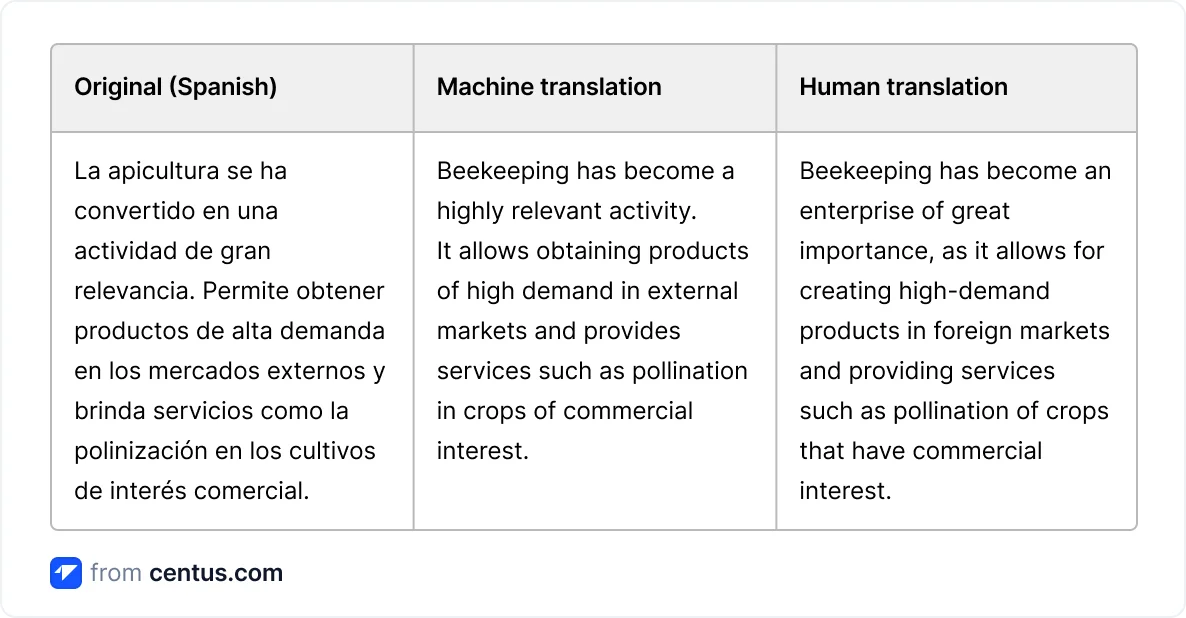
As you can see, the Google-translated sentences are disjointed, and the grammar, readability, and flow need to be improved for the text to make sense. Overall, machine translation could serve as a ‘quick read’ tool or for cases where the reader needs to get a general idea quickly.
Google Translate accuracy: English to Russian
While Google Translate is reliable for day-to-day tasks and simple, non-figurative texts, it cannot adequately capture the language’s nuance in marketing content or works of literature. Take a look yourself.
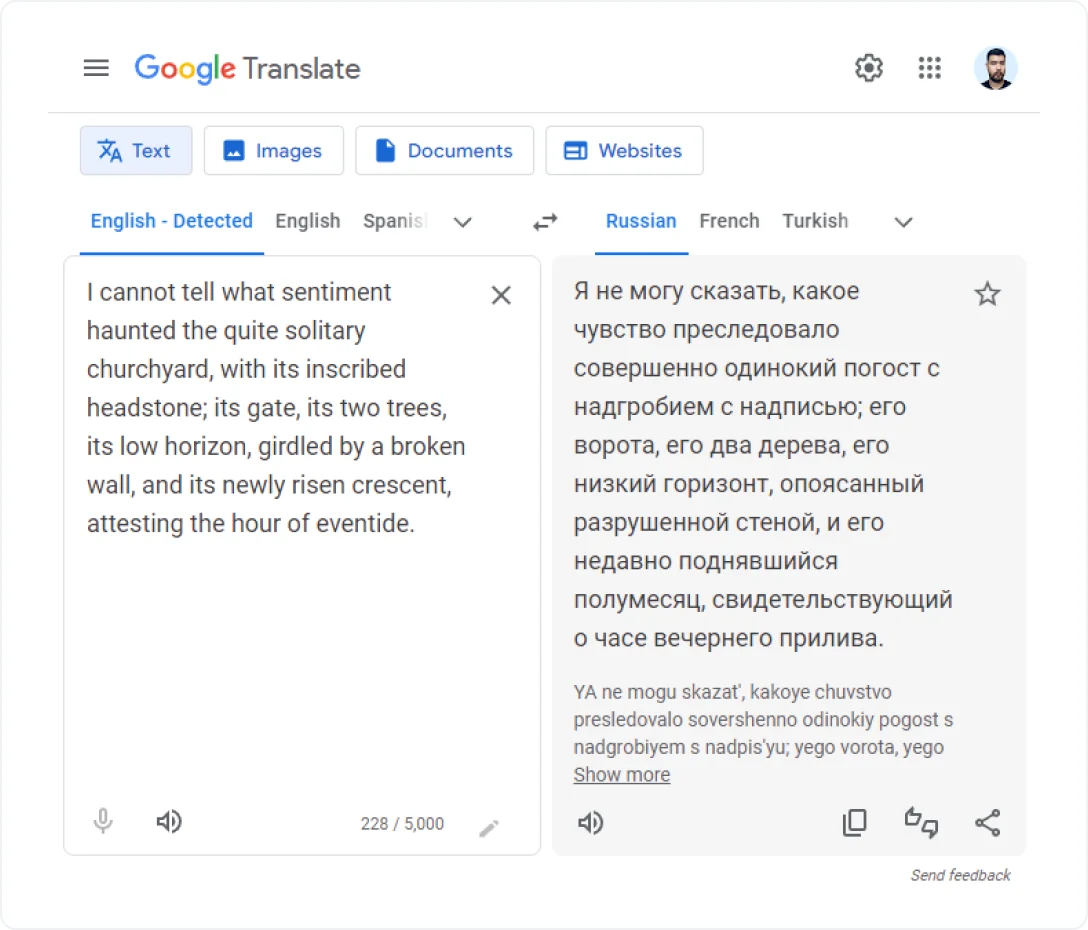
Here is an exhaustive list of the errors that Google Translate made in this example:
- Excessively literate translation
- Word-for-word translation
- Poor choice of words
- Extensive wording
- Unnatural word order in the target language.
In the table below you can compare both machine and human translations of the offered paragraph.
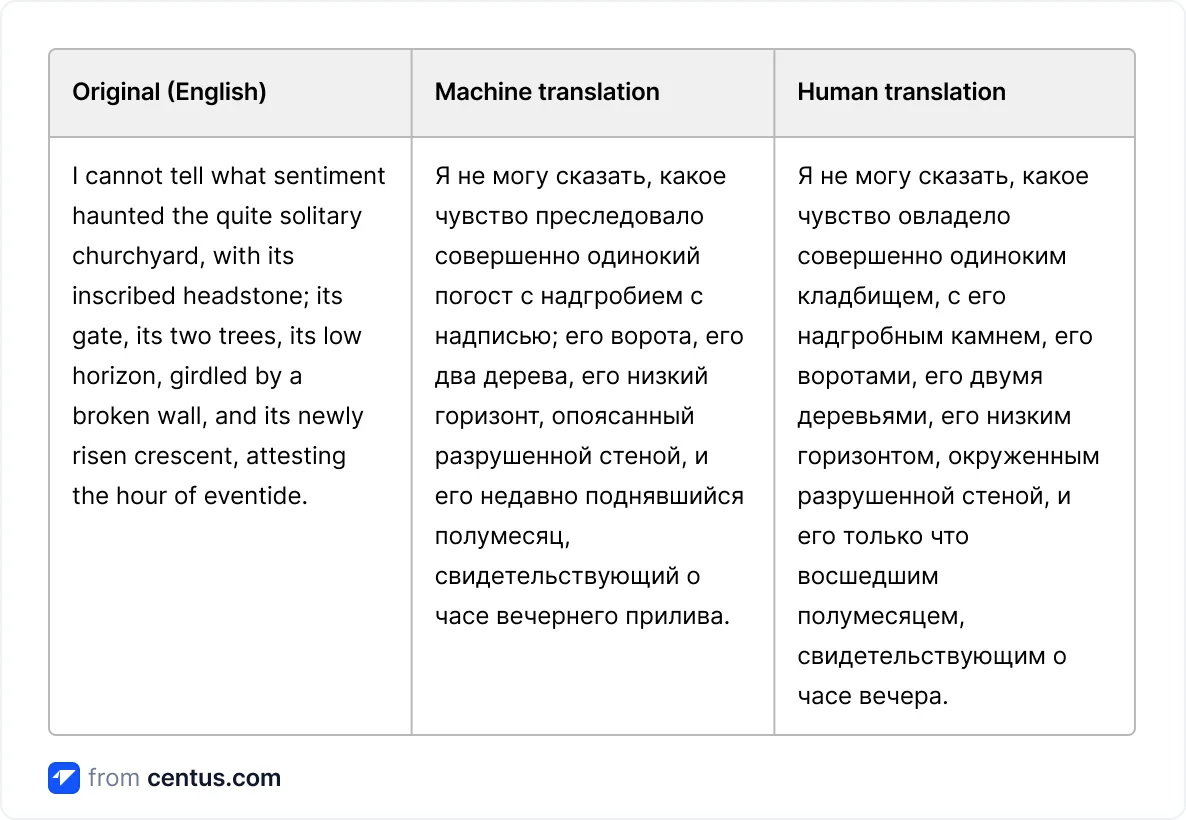
Google Translate is certainly suitable for a general understanding of the text. What it is not reliable for is posing as a professional human translator. So far, the score is: humans – 1, machines – 0.
Google Translate accuracy: English to French
In a simpler text experiment, machine translation has performed slightly better. This demonstrates the fact that Google Translate is a great tool for personal use—to grasp the general meaning of a piece of content.
Below you can see a text translated into French.
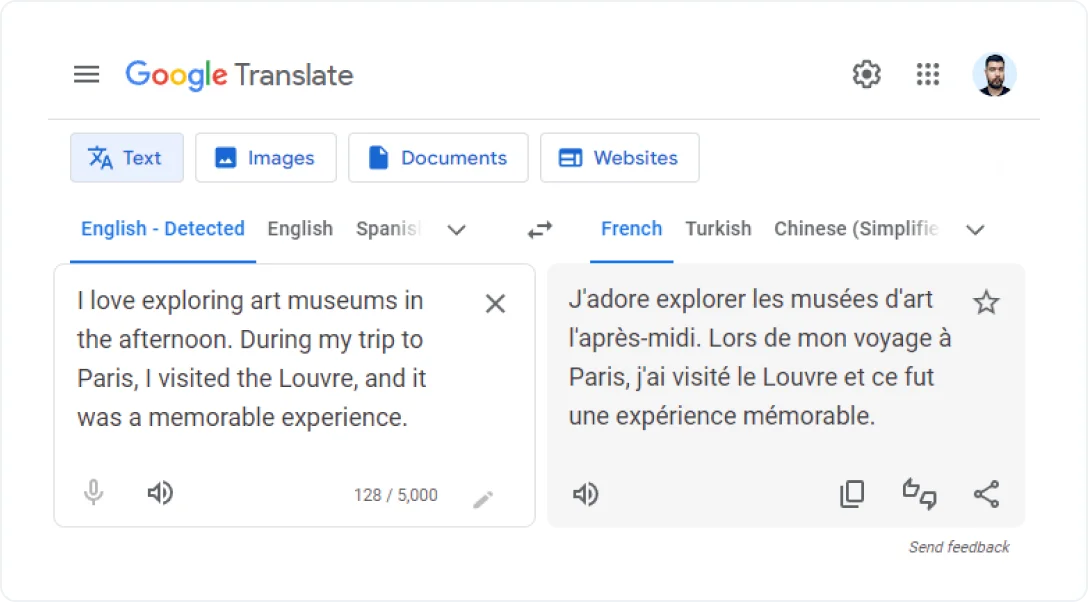
To understand how accurate Google Translate is for English-French translation, see the comparison table below.
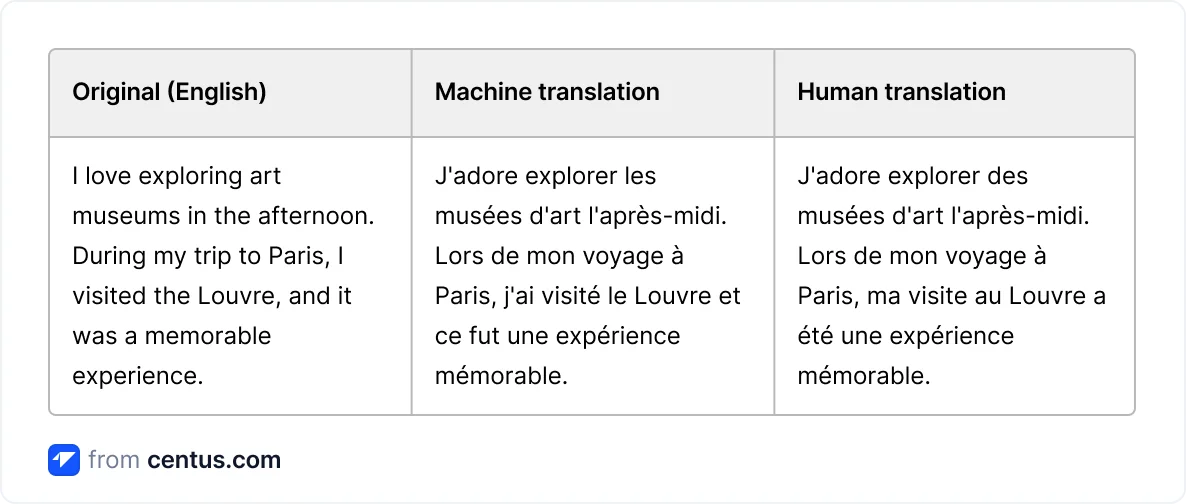
What if we try a less common language pair?
Google Translate accuracy: English to Tagalog
Tagalog, a major language in the Philippines, presents unique challenges for machine translation, particularly in colloquial phrases and local idioms.
Let’s see how accurately Google Translate can translate it. Note that the tool lists this language pair as English-Filipino.
As you can see, Google Translate struggles with cultural expressions and idioms.

Issues in the Google Translate’s version include:
- Formal and stiff translation tone
- Literal word-for-word translation
- Lack of colloquial and culturally appropriate language
- Awkward and unnatural phrasing
The issues become more pronounced when you place the machine-translated excerpt side-by-side with a human translation.

Note the succinct and emotive structure in the human translation. Another miss for Google Translate.
Let’s try another language pair.
Google Translate accuracy: English to Portuguese
Portuguese is a language widely spoken in Brazil and Portugal. It offers a test case for Google Translate's capabilities in handling Romance languages distinct from Spanish.
In this test, we examined tourist information, since these two countries are thriving holiday hotspots.
Here’s what we found out.
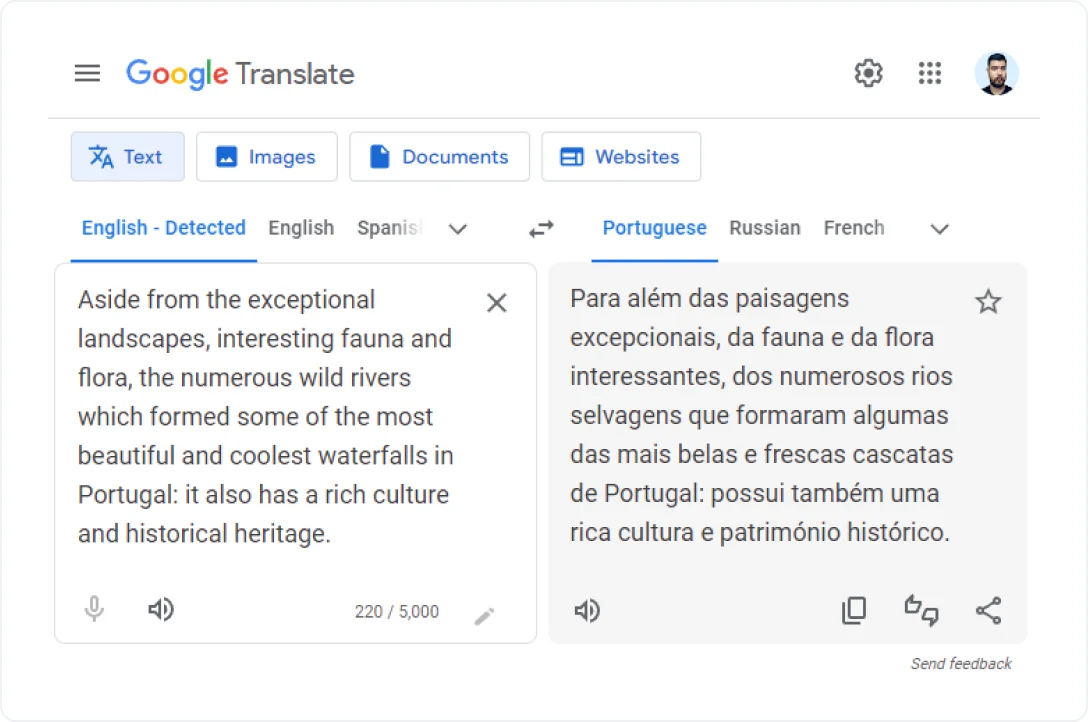
The shortcomings of Google Translate’s version are:
- Use of unnecessarily formal language
- Choice of words not fully aligned with common usage
And here is the table for a fuller comparison.
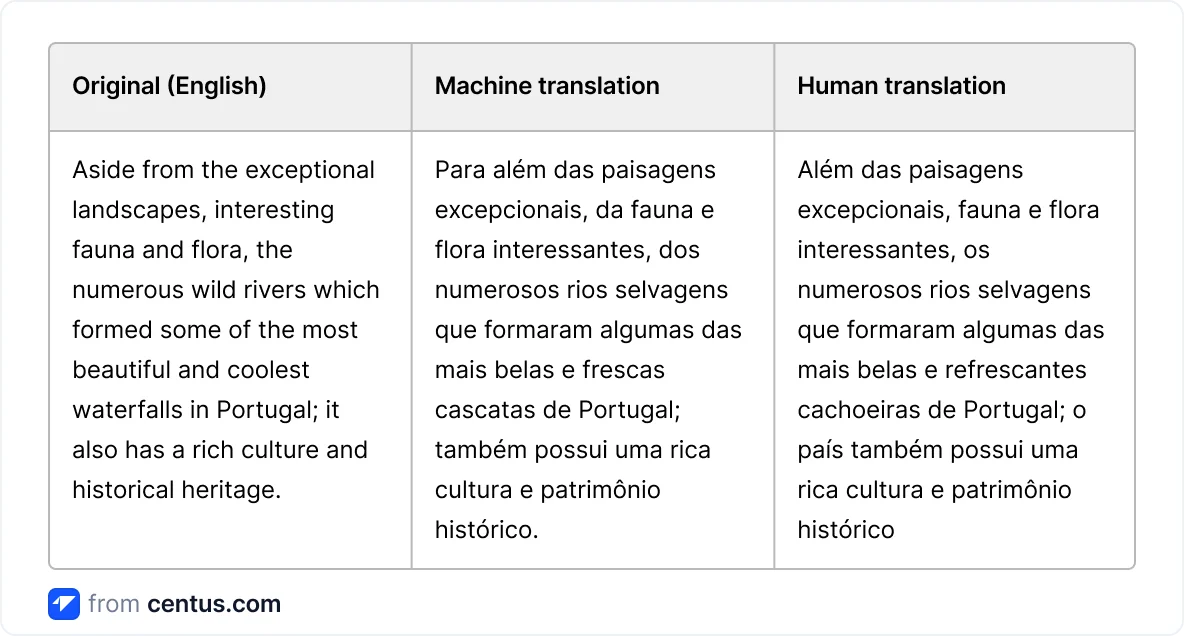
As you can see, there isn’t much difference save for slight regional differences, which means Google Translate can easily handle Portuguese, including its informal variant.
Let’s try a harder language pair.
Google Translate accuracy: English to Japanese
The English-Japanese pair is particularly interesting due to the significant differences in script, grammar, and syntax. This pair tests Google Translate's ability to handle complex character-based languages, especially in the context of formal business communication.
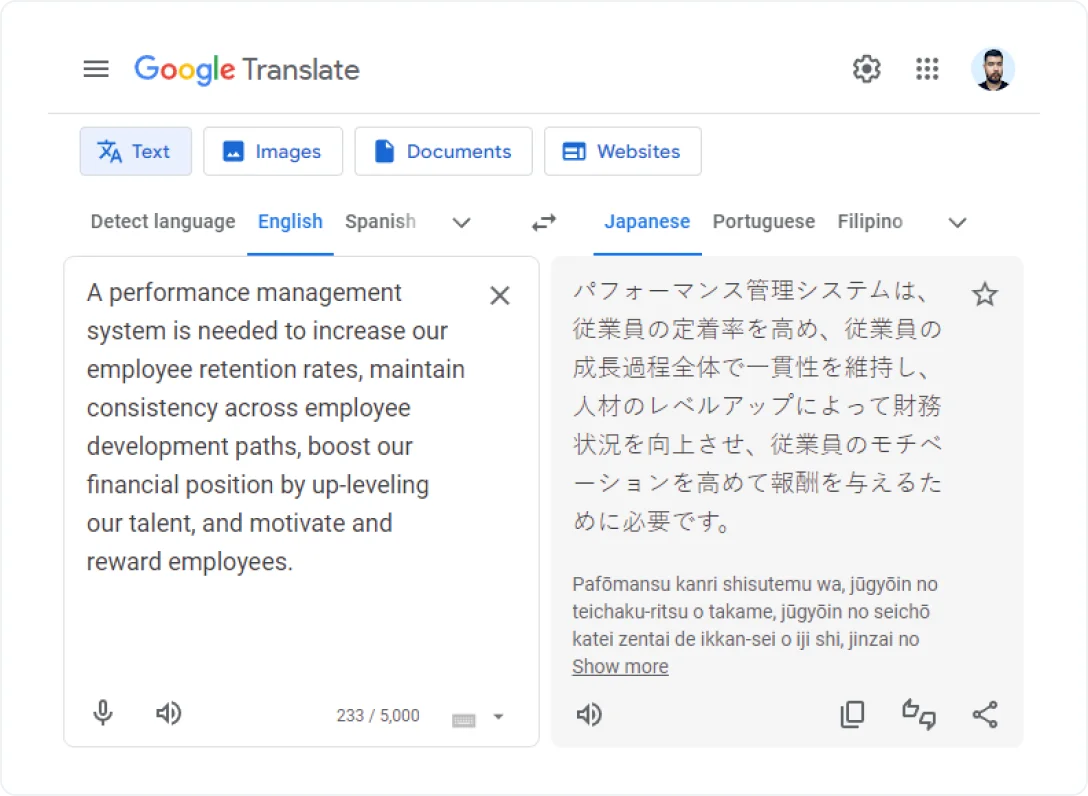
The shortcomings of Google Translate’s version are:
- Excessively formal translation
- Overly convoluted translation
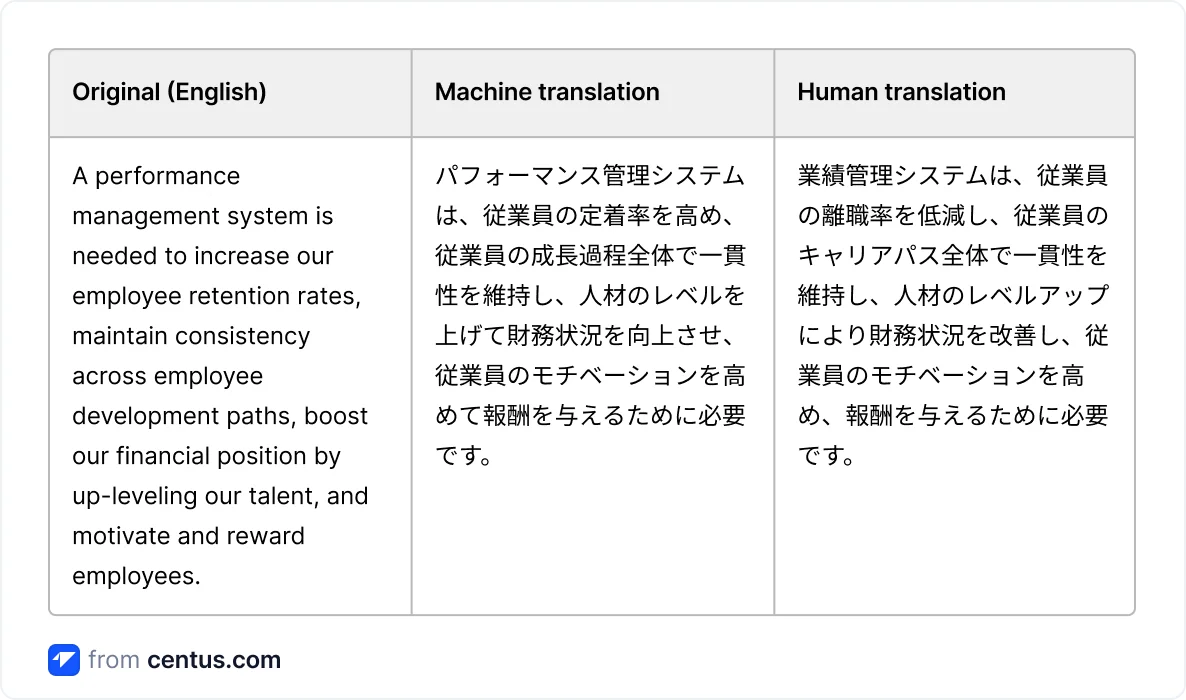
Google Translate's version is mostly right, although it tends to be overly formal and complex. For business documents, you should opt for simpler, yet not informal, language.
Now, what if the language pair features compound terms?
Google Translate accuracy: English to German
Shifting our focus to German, a language known for its compound words and syntax, we assess how well Google Translate can manage these linguistic features when translating highly technical documents from English.

While Google Translate delivers the gist accurately, its German translation can sound unnatural due to the literal phrasing (rund um) and lack of conciseness (Anforderungstexte). Using more natural word choices and shorter alternatives (Anfragetext) would improve clarity and readability for a German audience.
The difference in conciseness becomes even more obvious when you place machine- and human-translated versions side-by-side.
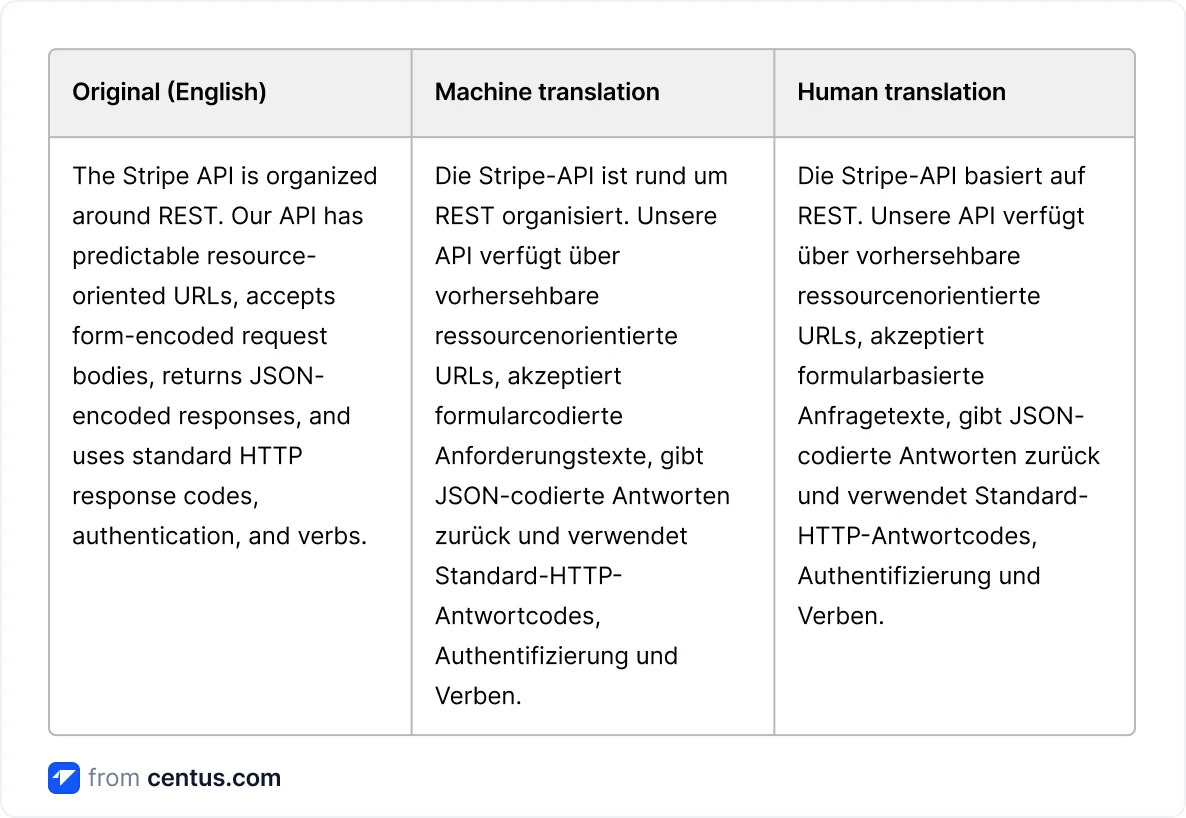
Google Translate accuracy: Italian to English
Italian is a nuanced language with multiple dialects and an emphasis on verb conjugations. Our analysis offers insights into the accuracy of Google Translate in this context.
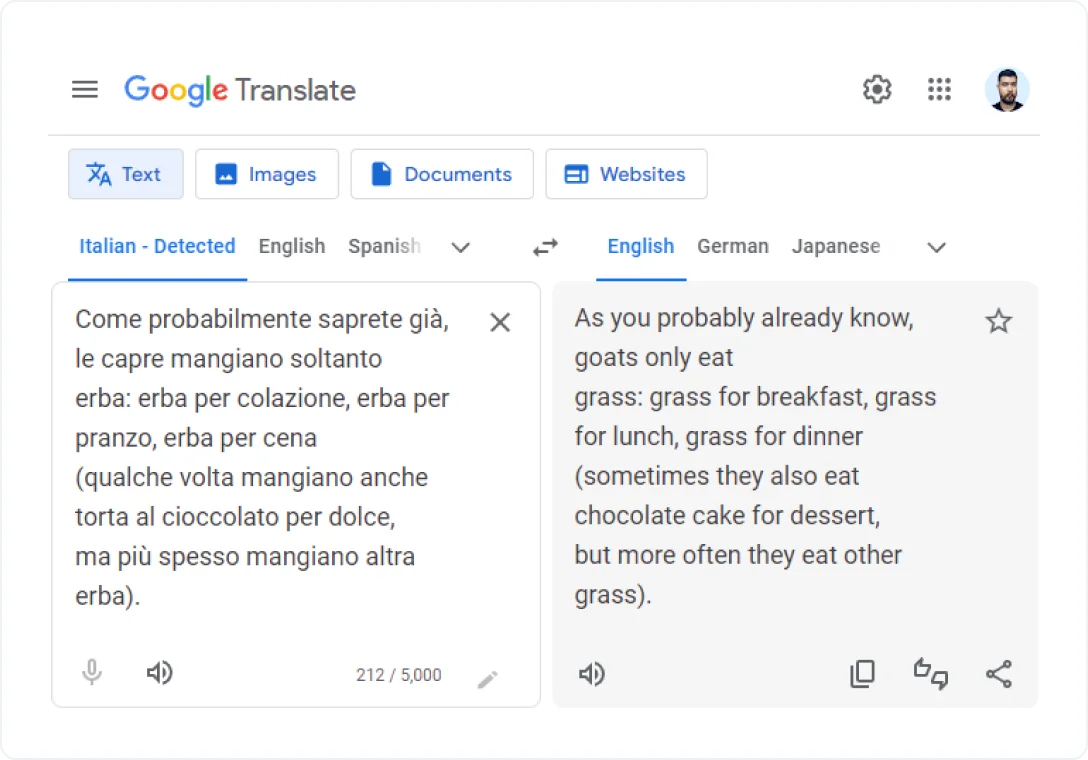
Limitations in the Google Translate version include:
- "Already" adds emphasis not present in the original Italian "saprete già"
- Google Translate translates "altra erba" (more grass), as simply "other grass" losing the playful repetition
This buttresses the observation that even with informal text, Google Translate struggles with subtleties like humor or sarcasm, resulting in a less engaging version of the original text.
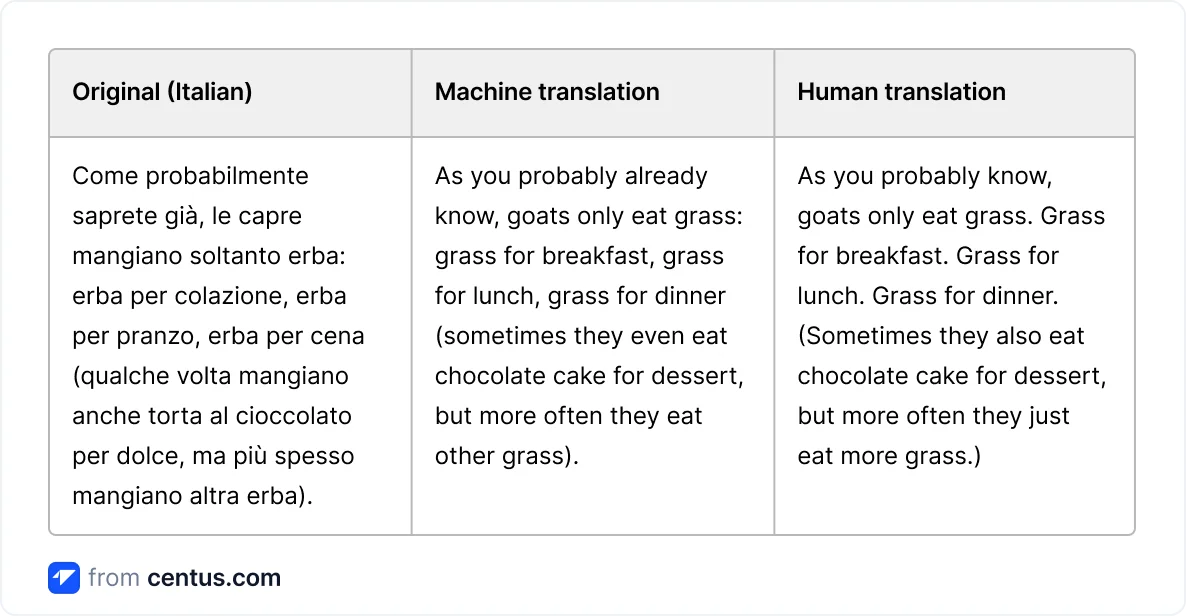
Google Translate accuracy: English to Korean
The Korean language is another language with formal and informal tones, which presents a real challenge for machine translation. We assessed how effectively Google Translate manages these tonal variations, especially in formal business communications.

Errors in Google Translate's version:
- Unnatural word order
- Incorrect word choice
- Fails to convey the formality of the original text
All these issues are notably absent in the human-translated version below:
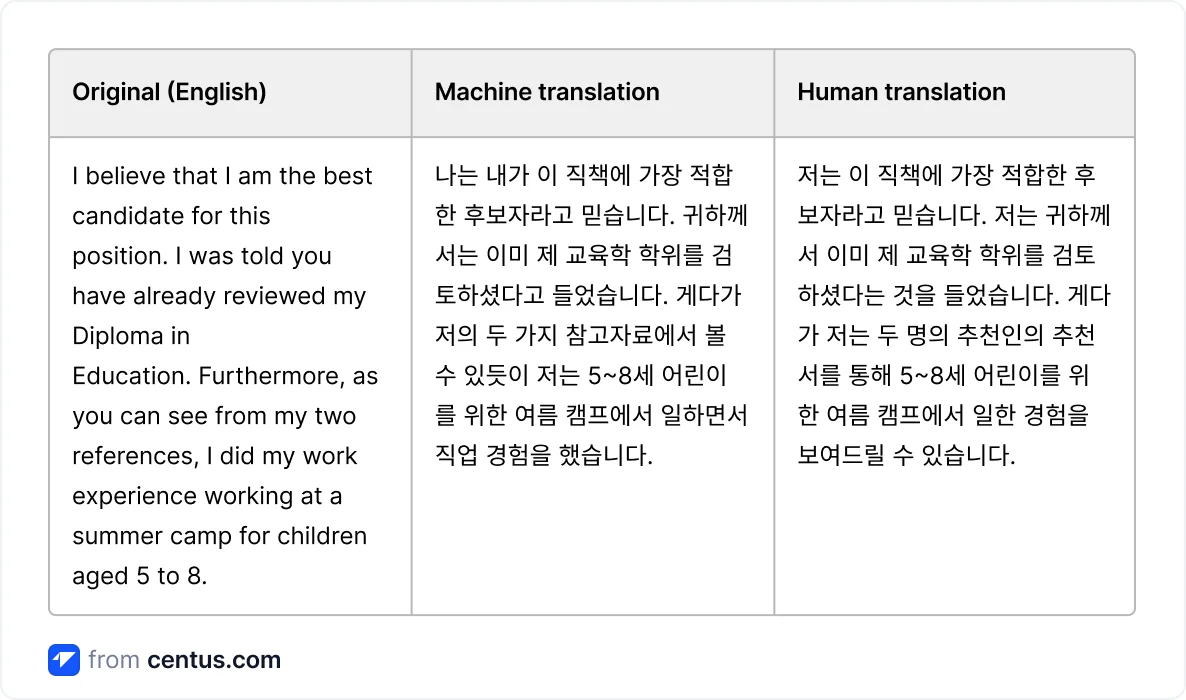
Google Translate accuracy: English to Swedish
In examining the English-Swedish pair, we explored how Google Translate deals with a North Germanic language, looking at both grammatical accuracy and the handling of cultural idioms. Our study included the translation of environmental policy documents from English to Swedish.
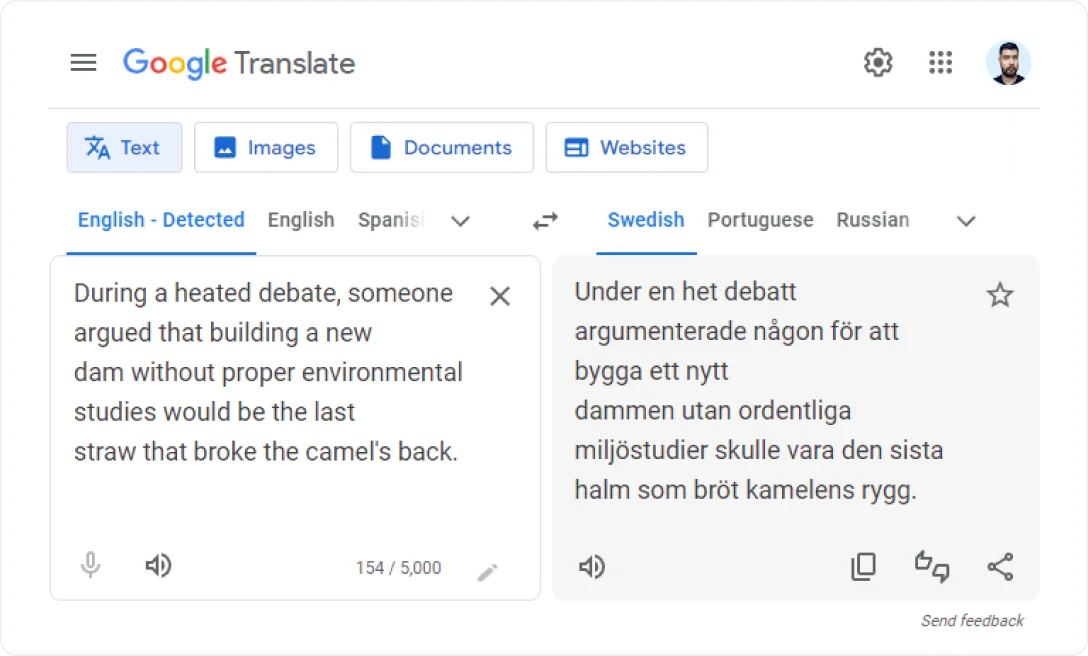
Google Translate's Swedish translation contained several mistakes. Apart from repeated words and messed up verb tenses, the idiom was translated literally—“camel’s back.” A better substituted would be the Swedish idiom—“cup run over.”
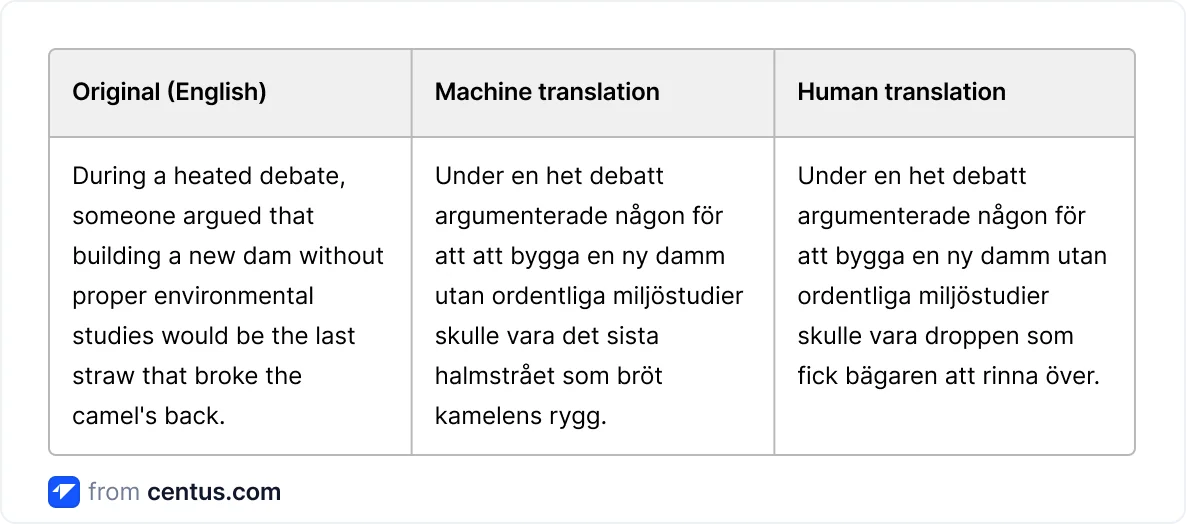
Google Translate accuracy: English to Simplified Chinese
This language pair challenges Google Translate's ability to handle a tonal language with a different grammatical syntax. Our experiment focused on translating a simple informal text from English to Simplified Chinese.
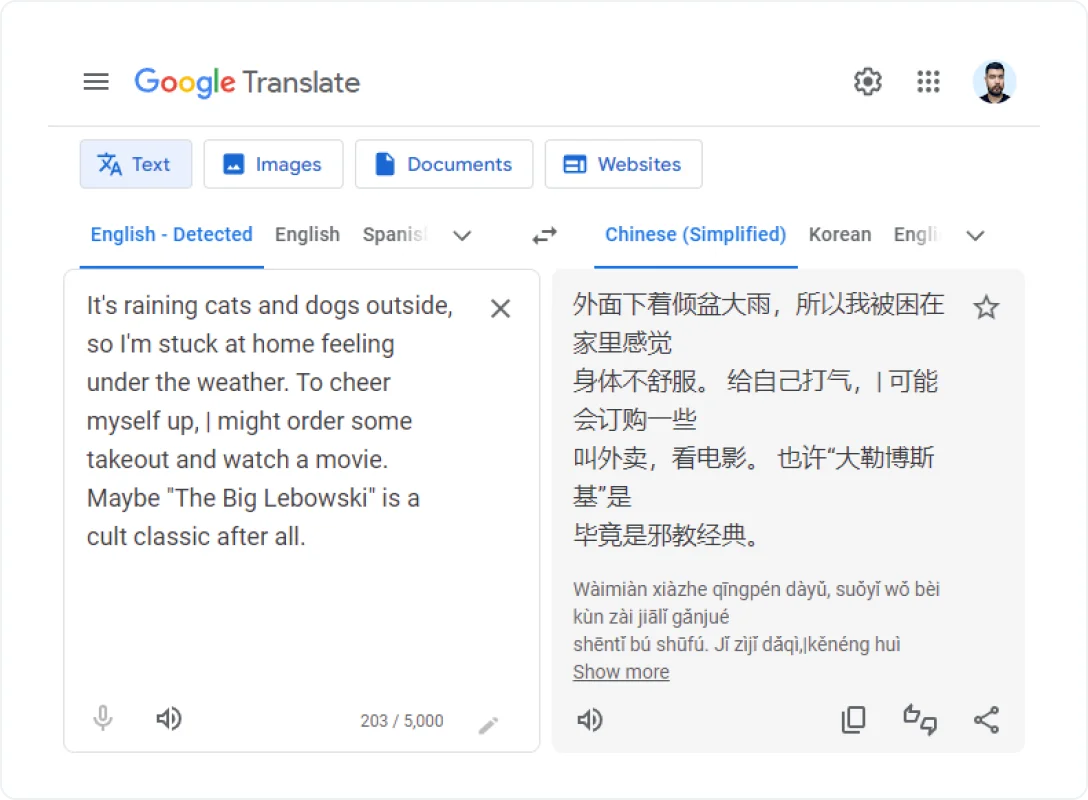
The Chinese version above roughly translates to, “It was pouring rain outside, so I was stuck at home and not feeling well. To cheer myself up, I might order takeout and watch a movie. Maybe “The Big Lebowski”—it’s a cult classic after all.”
It doesn’t convey the idiom properly and features awkward phrasing. Here’s a better translation below.
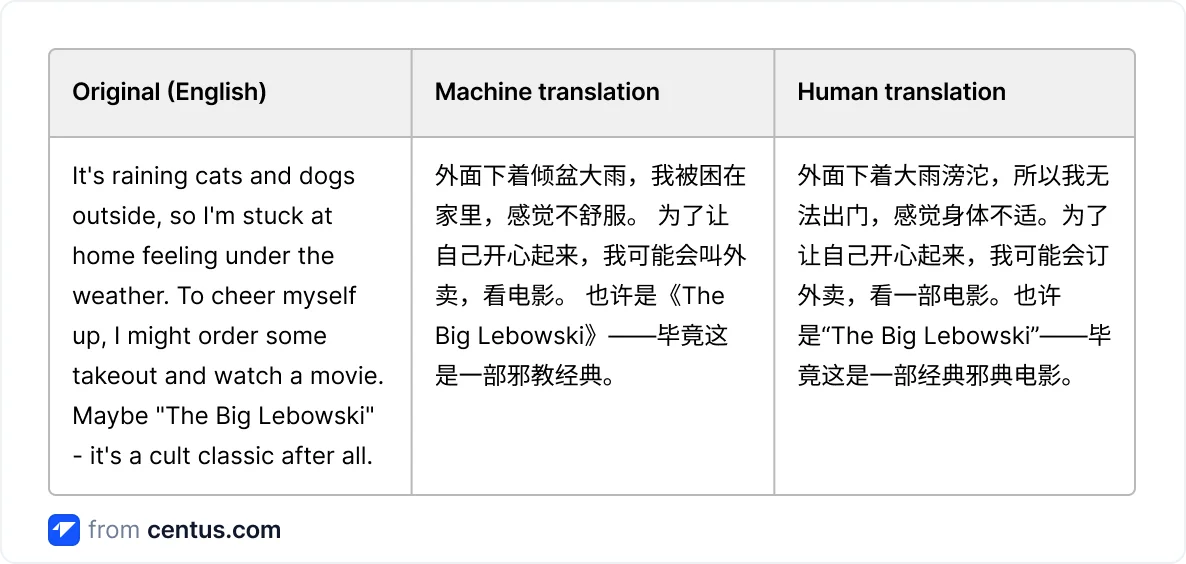
Finally, what if we try a more niche language?
Google Translate accuracy: English to Turkish
While Google Translate is helpful, English-to-Turkish translations can be tricky, due to context-dependent English words and the use of Turkish suffixes to indicate tenses/possession.

Overall, Google Translate's translation is pretty good. However, it’s not as accurate or natural-sounding as the human translation. A human translator is able to better capture the meaning and tone of the original English text.
Here’s a side-by-side comparison:

The bottom line is, you should use Google Translate for:
- International travel (road signs and menus)
- Skimming non-English websites
- Conversations with overseas relatives and friends
However, you should think twice before using Google Translate for:
- Business documents
- Financial, medical, or legal materials
- Advertising or public-facing content
How reliable is Google Translate? Why does it make mistakes?
Translate is not 100% reliable. Like any machine translation engine, it makes occasional mistakes. If a sentence or word pair is frequently translated in a certain way, Google suggests it as the appropriate translation, even if it is incorrect. For instance, the Italian word "costume," which means “swimsuit,” is often translated as "costume" in English.
Despite utilizing deep learning algorithms, Google Translate remains just an algorithm. It does not comprehend the text but rather plays a statistics game.
Furthermore, translating a language often involves breaking its rules, which is known as creativity. And since Google Translate’s capacity for creativity is limited by its language model, the tool keeps making mistakes.
Google Translate vs. popular machine translation tools
When it comes to machine translation, Google Translate is often the first name that comes to mind. However, it is not the only tool available. Let’s compare Google Translate with some of the most popular machine translation tools on the market today.
Google Translate vs DeepL
DeepL is a machine translation engine that uses deep neural networks to generate high-quality translations.
In a study on the translation of Spanish idioms, DeepL outperformed Google Translate with accuracy rates of 89 percent and 86 percent, respectively.
Google Cloud Translation vs. Google Translate
Google Cloud Translation is a machine translation service designed for businesses and developers who require a more robust and customizable translation service.
Both tools show higher popularity among small business representatives.
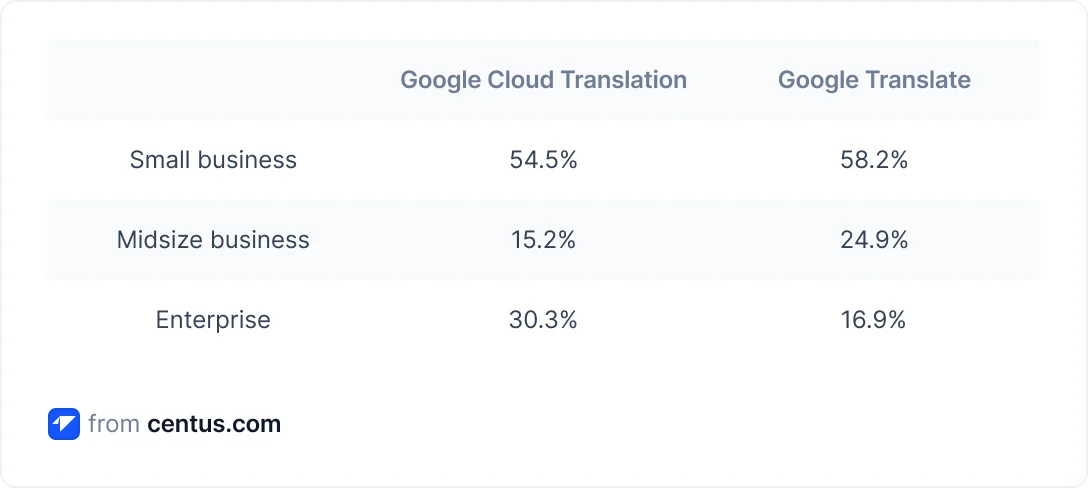
Amazon Translate vs. Google Translate
Amazon Translate is another popular machine translation service that is part of Amazon Web Services. It uses neural machine translation to provide high-quality translations for text and speech. Amazon Translate is designed for businesses that need to translate large volumes of content quickly and accurately.
The table below shows that when compared to Google Translate, Amazon Translate is favored by small businesses.
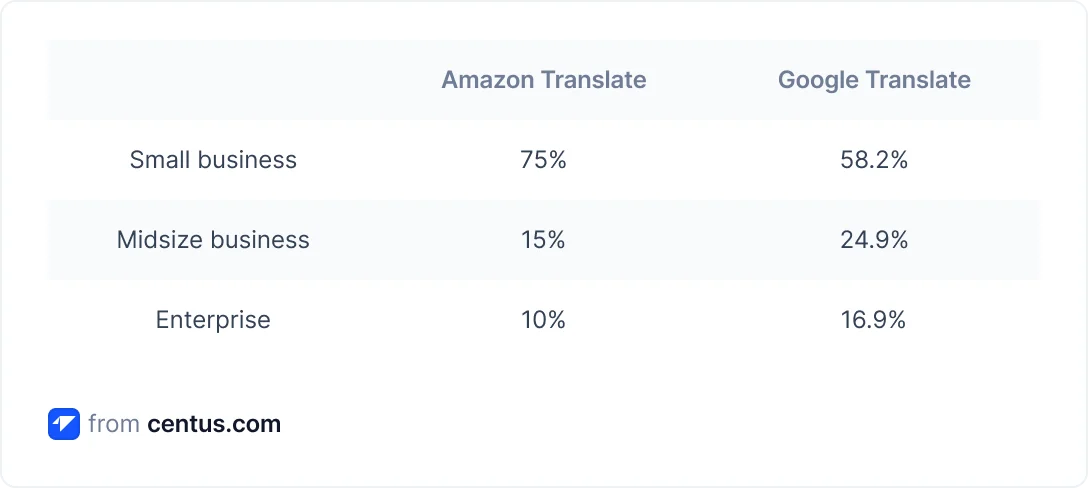
Microsoft Translator vs. Google Translate
Microsoft Translator is a machine translation service provided by Microsoft. It uses neural machine translation and artificial intelligence to provide high-quality translations for text, speech, and even images. Microsoft Translator is designed for businesses, which is very similar to Amazon Translate’s target audience.
According to G2, Google Translate stays in favor among small business representatives when compared to Microsoft Translator.

Get the week's best content!
By subscribing, you are agreeing to have your personal information managed in accordance with the terms of Centus Privacy Policy ->
Keep learning

5 min. read
Is DeepL Accurate? 2024 Research
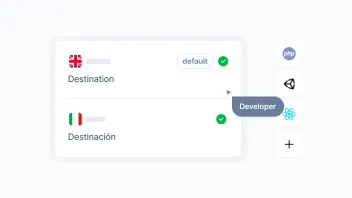
8 min. read
How to Choose the Right Translation Technology in 2025

9 min. read
7 Best Machine Translation Software Tools
8 min. read
What Is AI Translation and How to Use It?
13 min. read
What Is Segmentation in Translation?
15 min. read